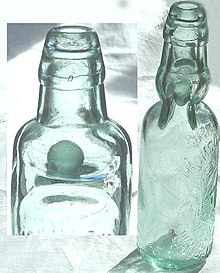Ball cap bottle


The ball cap bottle is a form of beverage bottle for carbonated drinks. It is closed by a glass ball ( “clicker” or “knicker” ), which is pressed against a rubber ring in the bottle neck by the pressure inside the bottle. Ball stopper bottles were common in the trade and sale of mineral water , lemonades and showers before beverage bottles with swing top or crown corks appeared. Because of the frequent sale of effervescent bottles in kinker bottles , this was also called kinker water or kinky water .
functionality
The ball lock works on the principle of a ball valve . It consists of a glass ball that can move freely inside the bottle and a rubber ring, which is embedded as a seal (valve seat) in the glass below the bottle opening. The opening of the ring is smaller than the glass ball. The ball is pressed against it by the pressure in the bottle from below and seals the opening tightly. This only works as long as the force that acts on the ball through the pressure inside the bottle is greater than the ambient air pressure plus the weight of the ball minus the static friction between the ball and rubber.
To open the closure, the ball must be pressed from the outside with an appropriate force so that the gas can escape. A finger or a more handy opener consisting of a stick in a wooden cap can be used for this. The ball moves minimally and releases a gap between the ball and the rubber ring. The carbon dioxide gas flows through this from the bottle. The internal pressure drops to the ambient level. The ball is then only exposed to the force of weight and falls into the drink.
So that the ball does not roll back into the rubber ring when emptying or drinking from the bottle and thus closes the bottle again, bottles have a ball catch. This can simply be designed in the form of a horizontal shoulder of suitable rounding, so that the ball (glass has about twice the density of the drink) is held on the shoulder step when rolling back until the bottle is turned completely upside down. A more complex shape has a bottle that is tapered at the lower end of the neck as if it is squeezed on two sides, so that the ball cannot fall into the bottle's belly and the bottle has a diameter marking; If the bottle is now lifted with a suitable orientation, the ball only rolls up to "two noses" in the neck, which also catch the ball.
When filling, the bottle filled in an upright orientation must be turned upside down before the pressurized filling nozzle is removed. This allows the ball to fall into the rubber ring. When the bottle is separated from the nozzle, there is no pressure on the outside of the ball and the bottle is closed by the greater internal pressure.
history
The ball closure bottle was invented by the Englishman Hiram Codd , who developed it in 1872 and applied for a patent. In the years that followed, it became popular around the world, with beverage manufacturers who wanted to use the technology initially having to pay annual license payments to Codd, but later had to buy the glass balls, locking rings and tools from Codd. In the English-speaking world, it is known as the Globe-Stoppered Bottle or, after its inventor, as the Codd (-neck) bottle .
Ball- cap bottles were very widespread for many decades, but were gradually replaced by bottles with swing top or crown corks . In England production was stopped around 1930, in Germany production continued until at least 1959.
Since there was a characteristic cracking noise when the bottle was opened, the name “Kracherl” became established for these lemonades in Austria, as well as in parts of Bavaria. In the 1950s, the bottles were called Boller (water) bottles after the content “ Bollerwasser ”.
The ball lock is still in use (2019) for the Japanese soft drink Ramune and the Indian “Banta”.
Modern version in a Japanese Ramune bottle
Knicker water
Ball- cap bottles were used for kinky water. It was offered in the flavors raspberry (red knicker water) , woodruff (green knicker water) and lemon (yellow knicker water) . Since the bottles were often smashed by children in order to get to the glass marble, relatively few specimens have survived and knicker bottles are rare collector's items.
Web links
- knicker bottle.de
- Entry on Codd Bottles at bottlebooks.com
- Please click once
- codd bottle testing . Video on YouTube , posted on April 19, 2009 (0:51 min), accessed on January 23, 2014.
literature
- George Burnet Beattie: The genius of Hiram Codd. An historical note on the Victorian who changed soft drinks bottling techniques for half a century. In: Bottling. 136, 1958, ISSN 0366-3752 , pp. 49-58 (also special reprint).
- Michael Polak: Warman's Bottles Field Guide. Values and identification. = Bottles field guide. 3rd edition. Krause Publications et al., Iola WI et al. 2010, ISBN 978-1-4402-1240-6 .
Individual evidence
- ↑ Claus Sprick: Hömma! Language in the Ruhr area . Straelener Manuskripte-Verlag, Straelen / Niederrhein 1984, ISBN 3-89107-001-2 , p. 51.
- ↑ Florian Müller: From Flappmännern and Klotschen . The West, May 29, 2007 (accessed August 7, 2010).
- ↑ Edward Fletcher: Antique bottles in color . Blandford Press, Poole 1976, ISBN 0-7137-0793-3 , p. 148.
- ^ Yearbook for West German State History, Volume 31, State Archives Administration Rhineland-Palatinate, self-published by the State Archives Administration Rhineland-Palatinate., 2005.
- ↑ Hans Dieter Baroth: "Knickerwasser" at the Seltersbude , accessed on August 7, 2010.



